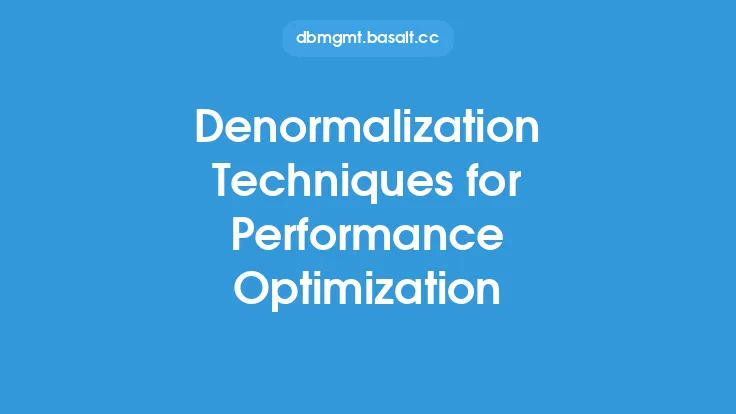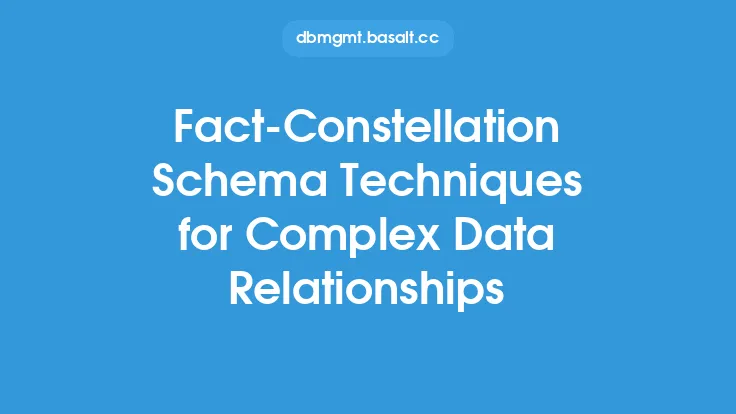When designing a database, one of the primary goals is to ensure that the data is stored in a way that minimizes data redundancy and improves data integrity. Data normalization is a technique used to achieve this goal by organizing data into tables with well-defined relationships. However, in some cases, data normalization can lead to slower query performance due to the need to join multiple tables. This is where data denormalization techniques come into play.
Introduction to Data Denormalization
Data denormalization is the process of intentionally deviating from the principles of data normalization to improve the performance of a database. This technique involves storing redundant data or grouping data in a way that reduces the number of joins required to retrieve the data. Data denormalization is often used in databases that require high performance, such as those used in e-commerce, social media, or real-time analytics applications.
Types of Data Denormalization
There are several types of data denormalization techniques, each with its own advantages and disadvantages. Some of the most common types of data denormalization include:
- Pre-aggregation: This involves storing pre-calculated aggregate values, such as sums or averages, to reduce the need for complex calculations at query time.
- Data duplication: This involves storing duplicate copies of data to reduce the need for joins or to improve query performance.
- Data caching: This involves storing frequently accessed data in a cache to reduce the need for disk I/O operations.
- Materialized views: This involves storing the result of a query in a physical table to reduce the need for complex calculations at query time.
Benefits of Data Denormalization
Data denormalization can provide several benefits, including:
- Improved query performance: By reducing the number of joins required to retrieve data, data denormalization can improve query performance and reduce the load on the database.
- Increased scalability: Data denormalization can help to improve the scalability of a database by reducing the need for complex calculations and joins.
- Simplified data retrieval: Data denormalization can simplify data retrieval by providing a single source of truth for data, rather than requiring multiple joins to retrieve the data.
Challenges of Data Denormalization
While data denormalization can provide several benefits, it also presents several challenges, including:
- Data inconsistency: Data denormalization can lead to data inconsistency if the redundant data is not properly synchronized.
- Data redundancy: Data denormalization can lead to data redundancy, which can increase storage requirements and make it more difficult to maintain data integrity.
- Complexity: Data denormalization can add complexity to a database design, making it more difficult to maintain and update.
Best Practices for Data Denormalization
To get the most out of data denormalization, it's essential to follow best practices, including:
- Identify performance bottlenecks: Before applying data denormalization techniques, it's essential to identify performance bottlenecks and determine whether data denormalization will provide a significant improvement.
- Use data denormalization judiciously: Data denormalization should be used judiciously, as it can lead to data inconsistency and redundancy if not properly managed.
- Monitor and maintain data integrity: It's essential to monitor and maintain data integrity when using data denormalization techniques to ensure that the data remains consistent and accurate.
- Test and optimize: It's essential to test and optimize data denormalization techniques to ensure that they provide the desired performance improvements.
Data Denormalization Techniques for Relational Databases
Relational databases are designed to store data in a normalized form, with each table having a well-defined relationship to other tables. However, relational databases can also be optimized using data denormalization techniques, such as:
- Using indexes: Indexes can be used to improve query performance by providing a quick way to locate data.
- Using materialized views: Materialized views can be used to store the result of a query in a physical table, reducing the need for complex calculations at query time.
- Using data caching: Data caching can be used to store frequently accessed data in a cache, reducing the need for disk I/O operations.
Data Denormalization Techniques for NoSQL Databases
NoSQL databases are designed to store large amounts of unstructured or semi-structured data, and they often use data denormalization techniques to improve performance. Some common data denormalization techniques used in NoSQL databases include:
- Using embedded documents: Embedded documents can be used to store related data in a single document, reducing the need for joins.
- Using denormalized data: Denormalized data can be used to store redundant data, reducing the need for complex calculations at query time.
- Using caching: Caching can be used to store frequently accessed data in a cache, reducing the need for disk I/O operations.
Conclusion
Data denormalization is a powerful technique that can be used to improve the performance of a database. By intentionally deviating from the principles of data normalization, data denormalization can reduce the need for complex calculations and joins, improving query performance and increasing scalability. However, data denormalization also presents several challenges, including data inconsistency and redundancy, and it's essential to follow best practices to get the most out of data denormalization techniques. Whether you're working with relational or NoSQL databases, data denormalization can be a valuable tool in your arsenal, helping you to optimize database performance and improve the overall efficiency of your application.





